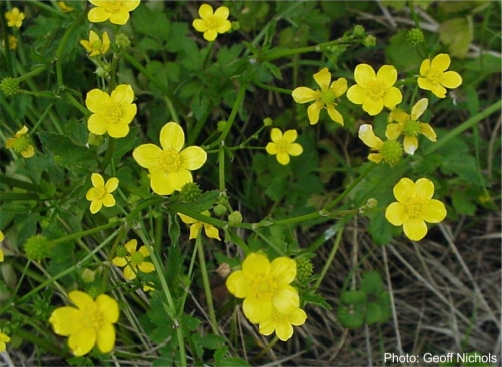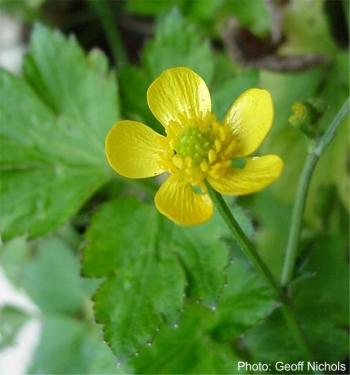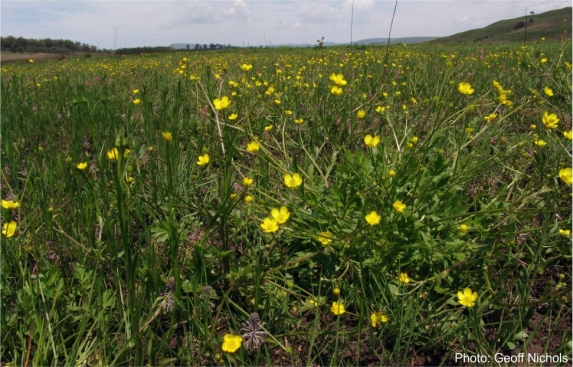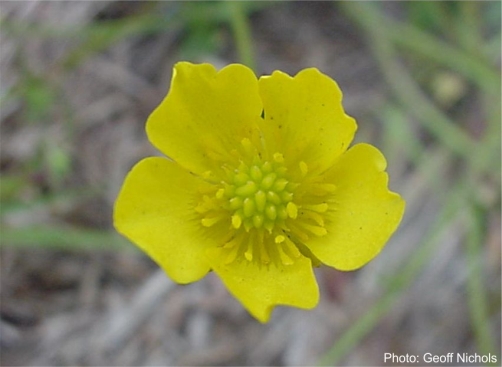Ranunculus multifidus
Ranunculus multifidus Forssk.
Family: Ranunculaceae
Common names: wild buttercup, common buttercup, African buttercup (Eng.); botterblom, brandblare, kankerblare, geelbotterblom, rhenoster (Afr.); hlapi (Sesotho); ishashakazane, isijojokazana uxhaphozi (isiZulu)
Introduction
Wild Buttercup is a small evergreen herb, with bright green leaves and masses of yellow flowers in summer, that grows well in damp grassland and spreads freely, therefore making an excellent groundcover.

Description
Description
Ranunculus multifidus is an evergreen herb, up to 1 m tall, with , bright-green, compound leaves that grow from a basal rosette. Leaves are 2-pinnate, the ultimate leaflets deeply and irregularly toothed and covered with hairs. It has colourful yellow flowers, about 15 to 20 mm in diameter, that are borne on branched inflorescences during summer (September to May). Fruit is an achene, 2 mm long.

Conservation Status
Status
Ranunculus multifidus is assessed as Least Concern (LC) in the Red List of South African plants because it is widespread and common and not threatened.
Distribution and habitat
Distribution description
Wild Buttercup grows in damp grassland, near streams and in marshes, from the coast up to 2 900 m and spreads freely by means of seeds and runners. It is also seen in disturbed places such as parks, gardens and roadside ditches. It is a widespread species of flowering plant in the family Ranunculaceae. It is native to southern and tropical Africa (apart from West Africa), Madagascar and Arabia.

Derivation of name and historical aspects
History
The name Ranunculus is derived from Latin and translate to ‘little frog’ and refers to the damp, marshy habitat of many species in this genus. The species name multifidus derives from the Latin words multi, meaning ‘many’ and fidus, meaning ‘divided’, referring to its leaves.
Ecology
Ecology
Ranunculus multifidus spreads easily and can become weedy. The flowers are visited by many different insects foraging for nectar and pollen.

Uses
Use
Wild Buttercup grows very fast and can provide cover quite quickly, an excellent groundcover for damp, sunny areas and beside streams or water features. It is used in traditional medicine to treat coughs, headaches, urinary complaints, throat ulcers, sores, wounds and pain.

Growing Ranunculus multifidus
Grow
Wild buttercup seeds germinate easily and the seedlings grow very fast. Sow the seeds in autumn or as they start to drop from the old flower heads, in a seedtray filled with a well-drained potting mix. Cover the seeds with a thin layer of finely milled bark or sand. Place the seed tray in the shade and water regularly. Grow the young plants on in pots until the rootstock is strong, before planting out into the garden.
References
- Cook, C.D.K. 2004. Aquatic and wetland plants of southern Africa. Backhuys Publishers, Leiden, The Netherlands.
- Exell, A.W. & Milne-Redhead, E. 1960. Angiospermae, Ranunculaceae. In: A.W. Exell and H. Wild (eds). Flora Zambesiaca 1 (Part 1):89-102.
- Manning, J.C. & Goldblatt, P. 2013. The native and naturalised species of Peltocalathos and Ranunculus (Ranunculaceae: Ranunculeae) in southern Africa. Bothalia 43(2):179-195.
- Pooley, E. 1998. A field guide to wild flowers Kwazulu-Natal and the eastern region. Natal Flora Publications Trust, Durban.
- Pooley, E. 2003. Mountain flowers, a field guide to the flora of the Drakensberg and Lesotho. Natal Flora Publications Trust, Durban.
- Sieben, E.J.J. 2009. The status and distribution of vascular plants (Magnoliophyta, Lycophyta, Pteridophyta). In: W.R.T. Darwall et al. (eds.), The status and distribution of freshwater biodiversity in southern Africa. IUCN, SAIAB, SANBI.
- Von Staden, L. 2015. Ranunculus multifidus Forssk. National Assessment: Red List of South African Plants version 2020.1. Accessed on 2022/12/06.
Credits
Thabo Masupa
National Herbarium, Pretoria
December 2022
Acknowledgements: the author thanks Geoff Nichols for providing images.
Plant Attributes:
Plant Type: Ground Cover, Perennial
SA Distribution: Eastern Cape, Free State, Gauteng, KwaZulu-Natal, Limpopo, Mpumalanga, North West, Northern Cape, Western Cape
Soil type: Sandy, Loam
Flowering season: Spring, Early Summer, Late Summer, Autumn
PH:
Flower colour: Yellow
Aspect: Full Sun
Gardening skill: Easy
Special Features:
Horticultural zones











Rate this article
Article well written and informative
Rate this plant
Is this an interesting plant?
Login to add your Comment
Back to topNot registered yet? Click here to register.